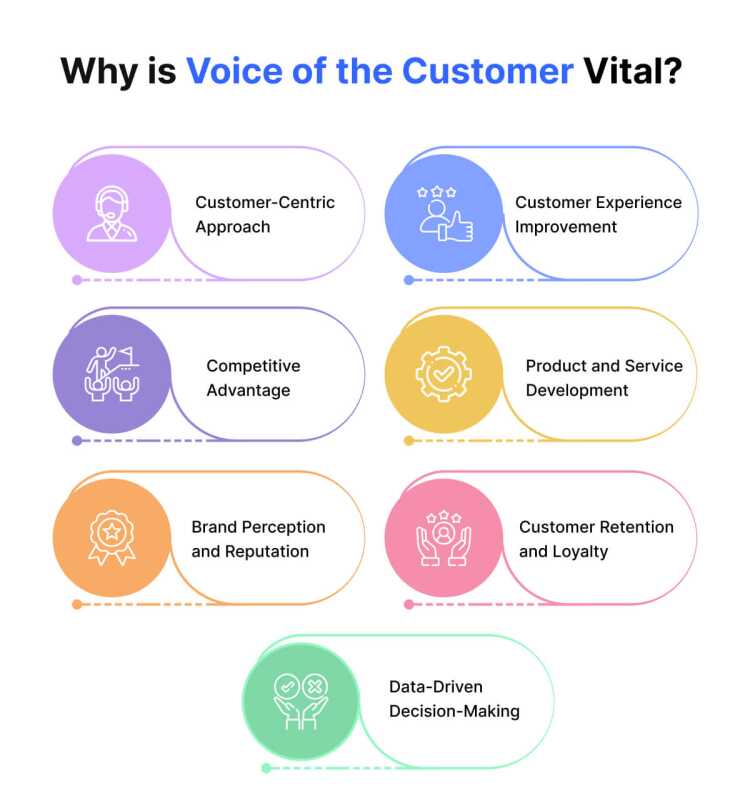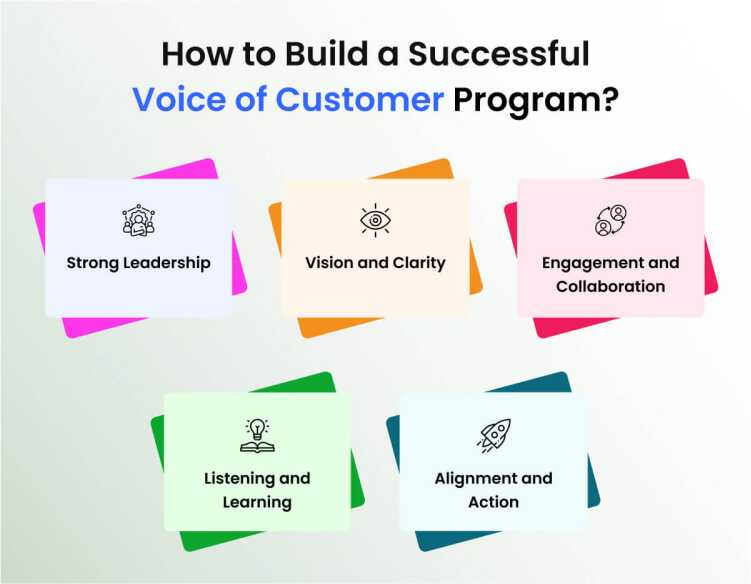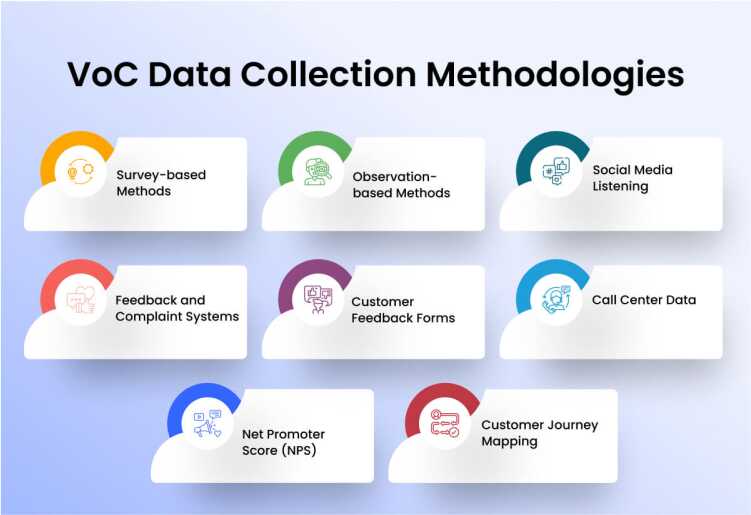In the business landscape, understanding the needs, expectations, and preferences of your customers is key to staying ahead. That’s where the Voice of the Customer (VoC) comes into play—a powerful tool that enables organizations to listen to the invaluable feedback shared by their customers.
By harnessing VoC, businesses can gain actionable insights that drive customer satisfaction, loyalty, and business growth. In this blog, we delve into the world of VoC data collection methodologies, exploring a range of techniques that will help you build a successful VoC program.
Let’s dive in and embark on a journey to create a customer-centric organization driven by the power of the Voice of the Customer.
What is the Voice of the Customer (VoC)?
The Voice of the Customer (VoC) refers to customers’ collective insights, needs, preferences, and expectations regarding a product, service, or brand. It represents the feedback, opinions, and sentiments shared by customers through various channels and interactions with a company. It captures the customers’ perspective, highlighting their desires, challenges, satisfaction levels, and suggestions for improvement.
The VoC is essential in understanding and meeting customer expectations, enhancing customer experience, and driving business success. By actively listening to the Voice of the Customer, organizations can gain valuable insights to shape their strategies, product development, marketing campaigns, and customer service initiatives.
Furthermore, it allows businesses to identify trends, patterns, and actionable areas for improvement, leading to better decision-making and ultimately creating more customer-centric offerings.
Why is Voice of the Customer Vital?
The Voice of the Customer is vital because it helps businesses understand, anticipate, and meet customer expectations effectively, ultimately driving customer satisfaction, loyalty, and business growth. The Voice of the Customer (VoC) is vital for several reasons:
- Customer-Centric Approach: The VoC provides direct insights into customer needs, preferences, and expectations. By understanding the customers’ perspective, businesses can align their strategies, products, and services to meet those expectations, resulting in a more customer-centric approach.
- Customer Experience Improvement: The VoC helps identify pain points, challenges, and areas of dissatisfaction experienced by customers. This knowledge allows companies to make targeted improvements, enhance the customer experience, and build long-term customer loyalty.
- Competitive Advantage: By actively listening to the VoC, organizations can gain a competitive edge by delivering superior customer experiences. Understanding what customers value and addressing their needs better than competitors can differentiate a business and attract more customers.
- Product and Service Development: It provides valuable insights for developing new products, enhancing existing offerings, or introducing new features. By incorporating customer feedback and preferences into the development process, companies can create products and services that align better with customer expectations.
- Brand Perception and Reputation: Customer feedback shared through VoC plays a crucial role in shaping brand perception and reputation. Positive customer experiences and strong brand advocacy can attract new customers and build a positive brand image, while addressing negative feedback can help prevent reputational damage.
- Customer Retention and Loyalty: By proactively addressing customer concerns and meeting their needs, companies can improve customer satisfaction, increase customer loyalty, and reduce customer churn. The VoC enables businesses to understand the factors influencing customer loyalty and take necessary actions to retain valuable customers.
- Data-Driven Decision-Making: The VoC provides quantitative and qualitative data that can drive data-driven decision-making across the organization. By analyzing VoC data, businesses can identify trends, patterns, and actionable insights that inform strategic decisions and operational improvements.
How to Build a Successful Voice of Customer Program?
To build a booming Voice of the Customer (VoC) program, consider the following key elements:
1. Strong Leadership
Ensure that there is strong leadership support and commitment to the VoC program. Leadership should advocate for the importance of customer feedback and drive its integration into decision-making processes.
2. Vision and Clarity
Define a clear vision and objectives for the VoC program. Identify what you want to achieve and how it aligns with broader business goals. Communicate this vision to all stakeholders to create a shared understanding and commitment.
3. Engagement and Collaboration
Involve stakeholders from across the organization, including employees, management, and customer-facing teams, in the VoC program. Foster a culture of collaboration and active participation, encouraging everyone to contribute their insights and ideas.
4. Listening and Learning
Implement mechanisms to actively listen to customer feedback from various channels, such as surveys, social media, customer support interactions, and feedback forms. Use analytics tools and sentiment analysis to gain insights from unstructured data. Regularly analyze and interpret the data to extract meaningful insights and trends.
5. Alignment and Action
Connect the VoC insights with key business processes and initiatives. Ensure that customer feedback informs decision-making across departments, including product development, marketing, customer service, and operations. Encourage a systematic and coordinated response to customer feedback to drive tangible actions and improvements.
6. Patience and Commitment
Building an effective VoC program takes time and persistence. Be patient and acknowledge that changes and improvements may take time to materialize. Maintain a long-term commitment to continue listening to the Voice of the Customer and making ongoing improvements.
VoC Data Collection Methodologies
It should be flexible and adaptive, evolving based on changing customer needs and feedback. Regularly review and refine your program, incorporating new methodologies and technologies to enhance the effectiveness of capturing and analyzing customer insights.
Survey-based Methods
Conduct surveys to gather customer feedback. It can include telephone surveys, in-person interviews, online surveys, and mail surveys. Surveys can be customized to capture specific information and measure customer satisfaction, preferences, and opinions.
Tips
- Keep surveys concise and focused to maximize response rates.
- Use a mix of open-ended and closed-ended questions to gather both quantitative and qualitative insights.
- Test surveys with a small sample group before launching them widely to ensure clarity and relevance.
- Offer incentives or rewards to encourage survey participation.
Observation-based Methods
Directly observing customer behavior, interactions, and experiences. This can involve on-site visits, mystery shopping, and video monitoring to gather firsthand insights into customer interactions with products, services, and employees.
Tips
- Clearly define the objectives and criteria for observation to ensure consistency and accuracy.
- Train observers to be discreet and non-intrusive while gathering data.
- Use technology such as video monitoring and wearable cameras for efficient and accurate data collection.
- Analyze and document observations promptly to avoid bias or forgetting important details.
Social Media Listening
Monitoring and analyzing conversations and feedback shared on social media platforms. Using sentiment analysis and social media monitoring tools, businesses can gain valuable insights into customer sentiment, opinions, and experiences shared on platforms like Facebook, Twitter, and Instagram.
Tips
- Utilize social media monitoring tools to track and analyze customer conversations in real time.
- Implement sentiment analysis to gauge customer sentiment and identify trends.
- Engage with customers on social media platforms to acknowledge feedback and provide timely responses.
- Monitor industry-specific hashtags and topics to gain insights into broader customer opinions and discussions.
Feedback and Complaint Systems
Implementing feedback and complaint channels to capture customer feedback. It can include customer complaint systems, suggestion boxes, helpdesk, support tickets, and online customer forums. These systems allow customers to share their opinions, suggestions, and concerns.
Tips
- Make feedback channels easily accessible and visible to customers.
- Promptly respond to customer feedback, whether positive or negative, to show that their voices are heard and valued.
- Regularly review and analyze feedback data to identify recurring issues and areas for improvement.
- Provide options for customers to provide anonymous feedback if they prefer.
Customer Feedback Forms
Utilizing feedback forms to collect structured feedback from customers. It can include paper-based forms, online feedback forms, and mobile app feedback forms. These forms can be tailored to specific areas of interest and can be distributed at various touchpoints in the customer journey.
Tips
- Keep feedback forms short and straightforward to encourage completion.
- Clearly state the purpose of the feedback and how it will be used.
- Use rating scales or Likert scales to capture quantitative data.
- Include open-ended questions to allow customers to provide additional comments and suggestions.
Call Center Data
Analyzing data from call centers, including call recordings, call transcripts, and customer satisfaction surveys. This data provides insights into customer interactions with customer service representatives, common issues, and customer satisfaction levels.
Tips
- Analyze call center data regularly to identify common customer issues and pain points.
- Implement quality assurance measures to ensure consistent and accurate data collection.
- Track customer satisfaction metrics and identify opportunities for agent training and improvement.
- Integrate customer feedback surveys within call center interactions to gather immediate feedback.
Net Promoter Score (NPS)
Measuring customer loyalty and satisfaction through the NPS methodology. It involves asking customers a single question to gauge their likelihood of recommending the company to others. The responses are then categorized into promoters, passives, and detractors, providing a simple metric to assess customer loyalty.
- Ensure the NPS question is clear and easy to understand for customers.
- Regularly measure and track NPS to identify trends and changes in customer loyalty.
- Follow up with detractors to understand their concerns and take appropriate actions to address them.
- Use NPS as a benchmarking tool to compare performance against industry competitors.
Customer Journey Mapping
Mapping out the customer journey and conducting qualitative interviews or touchpoint analyses to understand the customer experience at each stage. This helps identify pain points, areas of improvement, and moments that significantly impact customer satisfaction.
Tips
- Involve cross-functional teams to ensure a comprehensive understanding of the customer journey.
- Conduct qualitative interviews and focus groups to capture in-depth insights and anecdotes.
- Identify key touchpoints and critical moments that significantly impact customer satisfaction.
- Continuously update and refine the customer journey map based on new insights and changes in customer expectations.
Summary
Establishing a robust Voice of the Customer (VoC) program is vital for organizations aiming to deliver exceptional customer experiences and drive business success.
By implementing these tips, such as keeping surveys concise, leveraging sentiment analysis, promptly responding to feedback, and integrating customer insights into decision-making, businesses can build a successful VoC program.
It fosters a customer-centric approach, improves the customer experience, and enhances long-term customer loyalty.







